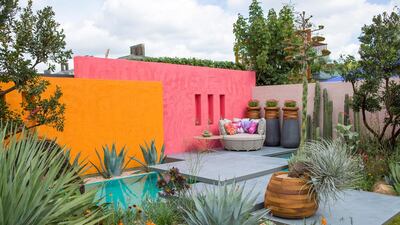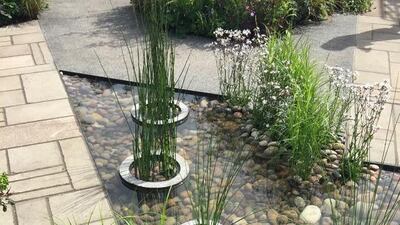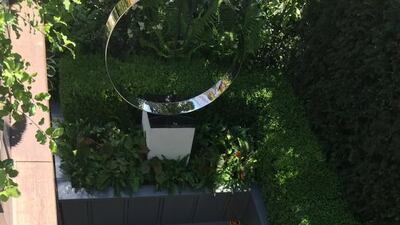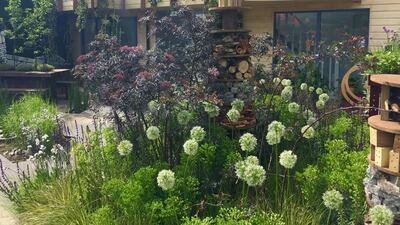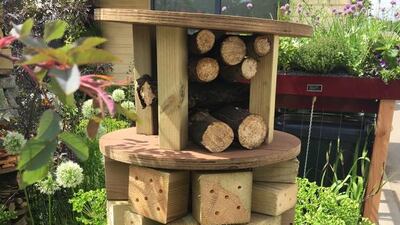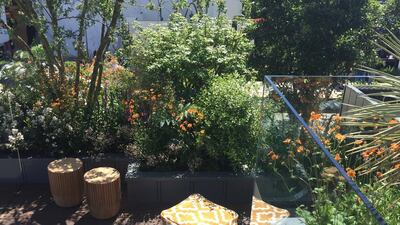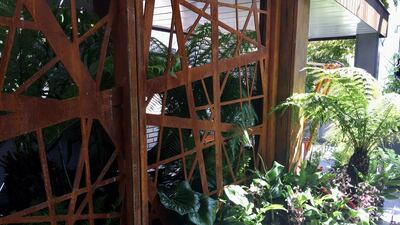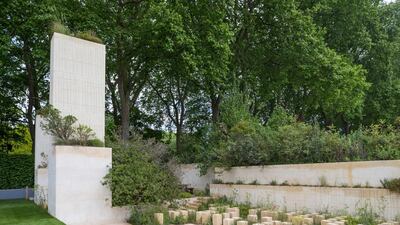About 160,000 visitors have made their way to London's Royal Hospital Chelsea this week for the most important event on the international horticultural calendar: the RHS Chelsea Flower Show.
It’s worth noting, in a country known for its greenery, abundance and plentiful rain, just how many of the world-leading garden designers presenting at this year’s show placed a focus on drought-tolerant planting, water conservation and the creation of greener spaces in urban environments. There was also an underlying message across the show that the simple pleasure of being around plants and flowers will reduce stress, promote well-being and offer genuine health benefits.
We take a look at some of this year’s leading show gardens to find ideas that can be applied in the UAE.
Inland Homes: Beneath a Mexican Sky by Manoj Malde
Awarded Silver Gilt in the Fresh Gardens category
Having been a successful fashion designer for the best part of two decades, Manoj Malde decided to apply his skills to garden design, and has already collaborated with leading designers such as Nick Bailey, Diarmuid Gavin and Chris Beardshaw on their Chelsea gardens.
In the year that he turns 50, Malde was determined to design a garden under his own name. His inaugural show garden, Inland Homes: Beneath a Mexican Sky, pays homage to the Mexican architect Luis Barragán and his bright colour palette. Born in Kenya but of Indian descent, Malde credits his early environment, which was filled with brightly coloured saris and the traditional clothing of the Masai tribe, for his affinity with his chosen palette.
The colour-wash walls are a signature of Barragán, and the garden was developed from a series of rectangular sketches crafted by Malde. Shades of clementine orange, pink coral and cappuccino were road-tested in various light conditions to find tones that were both warm in dull light and vibrant in full sun. It’s a colour combination that would work particularly well within a Middle Eastern courtyard or back garden, and really comes into its own in bright sunlight.
The colours of the walls provide a dynamic backdrop to some intuitive planting. “I was true to Mexico, with drought-tolerant planting. These are plants that grow in heat and poor soil, and yet survive,” Malde explains.
He’s particularly fond of the big velvety leaves of Kalanchoe beharensis and the dramatic Puya coerulea. The Agave parrasana, with its huge flower stalk, is a striking specimen plant and adds a sculptural height that punctuates the planting. The designer had to search hard for the two specimens of Arbutus unedo (multi-stem) trees that frame the garden, eventually sourcing them in a discarded part of a nursery he was visiting in Italy.
An aqua-blue pool and aged-copper horse sculpture by Rupert Till provide another nod to Barragán’s work, and introduce an equine motif that would also translate well in this region.
In terms of hard-landscaping, elements of the flooring consist of micro cement, a process that involves a thin layer of liquid, which includes a zinc resin, being skimmed on like plaster. When dry, this is sanded and polished to bring the zinc lustre through, creating a blended green/grey/blue base that beautifully offsets the colours of the walls.
City Living by Kate Gould
Awarded Gold in the Fresh Gardens category and Best Fresh Garden
Garden designer Kate Gould is a Chelsea regular, and has previously won four gold medals, as well as a prestigious Best in Category award. City Living is her eighth Chelsea garden and adds another gold medal and best gong to her tally. The garden is inspired by her experience of life in urban environments, where there may be little perceived scope for outdoor green space. Gould takes a view on the opportunities she finds, no matter how small, to provide usable green spaces and wildlife corridors in city areas. Her garden is built on three levels, on a 10-metre by 6-metre plot, and also carries a strong environmental message.
“I see this garden as a green route through to your apartment,” says Gould. “If you choose the right plants, or you’re creative about it, there’s no reason why you can’t plant [in between] these spaces. People respond well to green plants, it brings people together, people behave better around them and they are calming.”
The ground level of Gould’s design incorporates shade-loving plants and hardy sub-tropicals. The Philodendrons could be incorporated into almost any local planting scheme, for shady areas, along with Aspidistra elatior, Farfugium, tree ferns and hardy begonias.
Plant specimens requiring more light are used on the second deck level, where a jaunty floral combination of orange, purple and white prevails. On the third, top-level deck, sun-loving specimens such as Euphorbia and Echium webbii are incorporated.
None of the individual planting areas is particularly large, but the garden is cleverly considered so that there are touch points with plants all across the design, on the verticals, and at every level. Consequently, the planting feels abundant, yet remains relatively low maintenance.
The journey up and through the design includes a series of reveals, with aged steel panels that are reminiscent of Arabesque cut-out screens blending with sustainably sourced bamboo decking. An accent of bright orange is picked up along the way, with a drainage grid echoing the panel design, as well as elements of the lighting, all-weather soft furnishings and seating.
The M&G Garden by James Basson
Awarded Gold in the Show Gardens category and Best Show Garden
James Basson deployed his signature naturalistic show style for the M&G Garden. His aim was to communicate the message that “humans need to take action to preserve the fragile environment of our planet”. His striking design incorporates a series of limestone blocks evocative of a quarry he visited in Malta. Large hewn monolithic stones were set among the smaller blocks, some bearing deep markings to reflect the workings of the quarry, and interplanted with grasses, evergreens, perennials and ground cover unique to the Mediterranean island – some of which needed special government permission to be propagated and then brought out of the country.
The dramatic limestone environment hosts an interplay of various ecologies and soils, which are planted with drought-tolerant species, illustrating how nature adapts to reclaim an environment that is man-made. Basson’s garden had the longest, most-complex planting list of any I saw at Chelsea this year, reflecting evergreen woodland, cliff and shade planting, and using species not ordinarily seen in planned planting schemes.
A raised level with recycled wood seating and table provides richer greenery, and contrasts with the lower blocked areas, where the soil is poorer and the planting palette differs.
Basson is known for Mediterranean planting and a particular way of putting things together. He has studied the landscape, its vegetation and ecology and how plants naturally colonise spaces, interact and then reach a stable point of coexistence. “The root of that is extreme conditions and low resources,” Basson says. “All our gardens in the south of France need no additional irrigation; we just hydrate the first year by hand to get them going.
“Plant specimens for the show were kept in the south for as long as possible; the leaves were small and tight and they had a tougher, woodier feel. As soon as you bring them to England, the light levels are lower, and it’s cooler, and they start getting a bit soft once they arrive at Chelsea.”
Basson has an interest in tackling challenging and dry landscapes, and says that he would love to work on something in the UAE because “we’re into difficult climates”.
The RHS Greening Grey Britain Garden by Nigel Dunnett
Commissioned by the RHS
Nigel Dunnett is an RHS ambassador for the Greening Grey Britain campaign, committed to encouraging gardening and planting in urban environments and making garden spaces in new-builds meaningful, rather than just patches of green. The focus is easy maintenance and long flowering, which is “great for attracting wildlife and is full of interesting pollinators”, Dunnett says. He describes the insect and bee installations as “creature towers”.
“It’s artful ecology and they typify everything else here, which is multifunctional,” he says. “This is the future of how things could be with urban renewal and urban regeneration, and greening spaces for both private and community use.”
The wetland water feature takes recycled water from the roof. If there’s no rain, the feature can dry out and still look attractive and sculptural (with an accumulation of heavy stone pebbles abutting recycled municipal paving at angles).
“Hopefully the garden is seen as a source of inspirational, fun and practical ideas, as well as something decorative or cosmetic … sometimes there’s a problem with ecological ideas in landscape in that they are either really wild or they look very rustic, and possibly old fashioned, or they are just weird and wacky. What we have tried to do here is to make it smart and clean and modern, and still have all of this richness around.
“I’ve always had a passion for plants and gardens, and experiencing beautiful landscapes, and the feelings of uplift and joy that I felt when I was in a meadow … I felt I never really got that from gardens, so I trained as a plant scientist as I wanted to understand how nature worked. I think what I try to do with my gardens is to recreate that feeling of nature, rather than trying to copy it. In a way, it’s the opposite of James Basson’s garden, which aims to make a reproduction of a natural landscape or habitat. Here, this garden is trying to evoke the spirit of nature, something artful that will provide that emotional response.”
homes@thenational.ae
